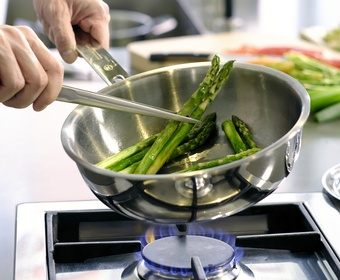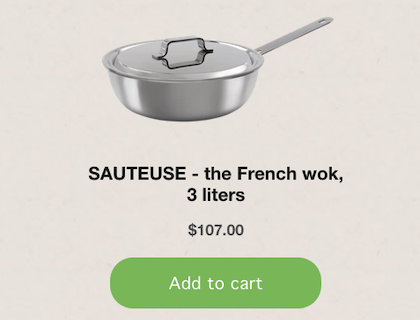About the sauteuse
'Sauter' is French for 'to jump' and the purpose of this bowl-shaped pan is to toss small amounts of food, so they 'jump' around for a short time while being subjected to high heat. And ensure it is served hot, but not overcooked. For some reason, this tool has yet to be discovered and appreciated in many home kitchens.
It is simply essential.
– Chef de Cuisine Albert Lindos firm opinion on the sauteuse
The last touch
The sauteuse is often used to cook and flavor decorative morsels of food that will provide the last touch on the plate. It is more closely related to a frying pan than to a cooking pot.
High heat essential
Sautéing is all about browning food without dehydrating it, and serving greens that are piping hot but still crispy. High heat is essential.
A little at a time
A sauteuse in a professional kitchen is modest in size. It is meant for fine tuning and for getting perfect results with small amounts of food at a time.
The right shape
The shape resembles a wok since the cooking principle is the same. Deep, rounded sides and a sturdy handle facilitate the right technique.
The right material
Non-stick surfaces don't like high temperatures, they will also be damaged by steel kitchen tools. Cast iron and carbon steel pans react with acidic ingredients, they are also excessively heavy materials for a sauteuse. But stainless steel is durable, relatively light, easy to clean and does not react with foods.
Dry and clean
Stainless steel is a durable and resistant material, but it may stain if subjected to water or corrosive ingredients for long periods of time. A clean and dry sauteuse is a better sauteuse.
On temperatures
- 0°C – Water freezes
- 5°C – Pathogens start/stop reproducing
- 57°C – Most pathogens die
- 78°C – Alcohol (ethanol) boils and evaporates
- 80°C – Optimal temperature for many teas
- 100°C – Water boils (and milk too)
- 140 – 165°C – The Maillard effect (food is seared/browned)
- 160 – 180°C – Suitable temperature for deep frying
How to sauté
- Prepare a mise en place: Peel, chop and organize ingredients in advance. You won’t have time to do this when sautéing.
- Give the sauteuse time to get hot. Then allow the fat being used for frying the time to get hot.
- Butter should stop hissing. If using oil, a little smoke is fine. If mixing oil and butter, the oil goes in first.
- Sauté a little food at a time. Practice the right upward “wrist twist” to get the morsels to “jump”.
- Flavor, plate and serve while it's hot.
Sauté in portions
Only cook a moderate amount of food in your sauteuse. Too much will cool down the pan, slowing down the cooking process.
The maillard effect
Browning meat gives rise to new flavors and aromas as proteins and carbohydrates react and form flavorful molecules in hundreds of combinations. This is known as the Maillard effect. The Maillard effect only happens on dry food. Therefore, the temperature must be above 100°C, ideally 140 – 165°C.
Uniform morsels
Food that goes into the sauteuse should be uniform in size. The idea is for every morsel to heat up and cook at the same time.
Fastest ingredients last
... and the one that takes longest to cook goes in first.
Sauteuse care
- Dishwasher detergents might contain abrasive substances that will give a steel sauteuse a dull appearance if machine washed often. The sauteuse’s qualities will not be affected.
- Clean with hot water and washing-up liquid and dry with a kitchen towel.
- Fill with water and leave for a few hours to loosen up and remove burnt food.




